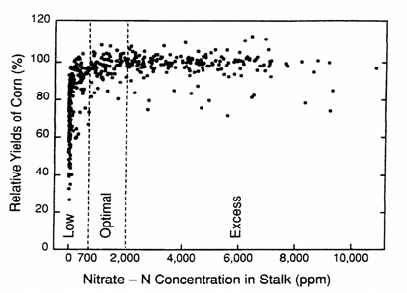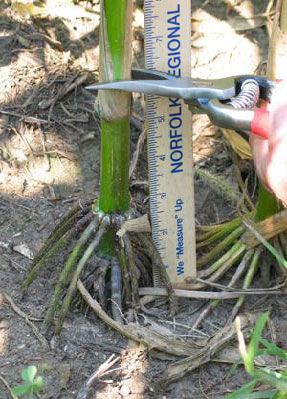End-of-Season Corn Stalk Nitrate Test (CSNT)
Introduction
Nitrogen (N) management is often a challenge in obtaining an economically optimum yield. This is because many factors influence nitrogen behavior in the soil, including its source, timing, and especially weather condition. A crop displaying dark green growth, late in the growing season, indicates that it has been over fertilized. This can be a problem especially with manure if mineralization has not been taken into account. On the other hand some visual symptoms of nitrogen deficiency late in the season may not always indicate a yield loss. Reliable tests for detecting N content of corn plants can improve profitability and reduce the potential for nitrate contamination of water supplies.
The lower portion of a corn stalk tends to function like a reservoir for nitrate N (NO3-N). During the grain-filling period, corn plants suffering from inadequate N availability tend to remove N from this reservoir as well as from lower leaves. Conversely, when corn plants are over fertilized, nitrate will accumulate in the lower portion of stalks without contributing to a greater yield. This may result in plants that are dark green in color.
Measuring the nitrate concentration in the lower portion of corn stalks, at the end of the growing season can be useful in determining nitrogen deficiency, sufficiency, or excess. Studies over a wide range of conditions have shown remarkably similar relationships between the amount of N found in the lower stalks late in the growing seasons, and the likelihood that corn had been under or over-fertilized (Figure 1). The Cornstalk Nitrate Test (CSNT), by itself or along with pre-sidedress N test (PSNT), can be used to gain confidence in the nutrient management and planning process. In years with a cool and/or wet spring, microbial activity responsible for decomposing organic matter is low. Under this condition, PSNT results may indicate the need for N fertilizer even though sufficient N may still be released from soils’ organic reserves when the temperature rises. The end-of-season cornstalk nitrate test can confirm if fertilizer was needed and help farmers decide on proper N application adjustment for future years.

Figure 1: Corn yield and stalk N relationship
Sampling Procedure
The test requires collecting corn stalks at the end of the season just before harvest. For grain corn, stalk samples should be taken between one and three weeks after there has been a black layer formation on 80% of the kernels.
Collect samples from 15 random plants for every 10 acres of field
Cut an 8 inch segment of stalk starting 6 inches above ground level (Figure 2)
Remove leaf sheaths from the segments
Avoid stalks damaged by disease or insect
Areas with differing soil types or management histories should be sampled separately
Place segments in a paper bag (not plastic as it promotes fungal growth) and dry or freeze for later analysis.
Send samples to:
Dairy One Forage Lab
730 Warren Rd.
Ithaca, NY 14850
Ph: 1-800-496-3344
Fax: 607 257-1350
Call ahead to ensure analysis.

Figure 2. Samples should be taken 6 inches from the soil.
Interpretation of Stalk Nitrate Concentration
Stalk nitrate concentrations for silage corn can be divided into four categories;
The Low category (<700 ppm): Indicates corn plants could have benefited from higher N fertilizer application. Visual signs of N deficiency usually are clear when nitrate concentrations are in this range.
The Optimal category (700-2000 ppm):
Indicates high probability that N availability was within the range needed to maximize profits for the producer. The higher end of this range is more appropriate when fertilizer N is relatively inexpensive and grain prices are relatively high. The lower end of the range is most appropriate when fertilizer N is relatively expensive and grain prices are relatively low.
The Excess category (> 2000):
Indicates that N in the field was in excess of what is needed for optimum economic yields. Not only might this represent an economic loss, but it may also indicate a potential for nitrogen loss to the environment. Nitrogen management should be evaluated to determine why the N supply was excessive and management changed accordingly
Note Measurement of nitrate concentration in the lower portion of corn stalks at the end of the growing season can be used to determine nitrogen deficiency, sufficiency, or excess in corn silage.
Resources
Blackmer, A. M. and A. P. Mallarino. Cornstalk testing to evaluate nitrogen management. Iowa State University Cooperative Extension Service.
Beegle, D., and J., Rotz. Late Season Cornstalk Nitrate Test. Agronomy fact # 70. Penn State University Cooperative Extension Service.
http://extension.psu.edu/plants/crops/grains/corn/nutrition/late-season-cornstalk-nitrate-test
For more information visit the UMass Extension Crops, Dairy, Livestock & Equine Program
Factsheets in this series were prepared by, Masoud Hashemi, Stephen Herbert, Carrie Chickering-Sears, Sarah Weis, Carlos Gradil, Steve Purdy, Mark Huyler, and Randy Prostak, in collaboration with Jacqui Carlevale.
This publication has been funded in part by the Massachusetts Department of Agricultural Resources and the Massachusetts Farm Bureau Federation, Inc.